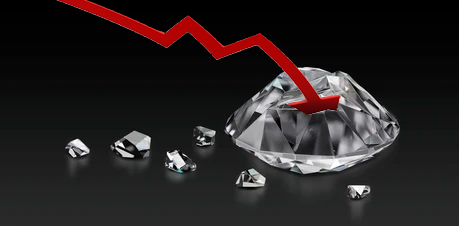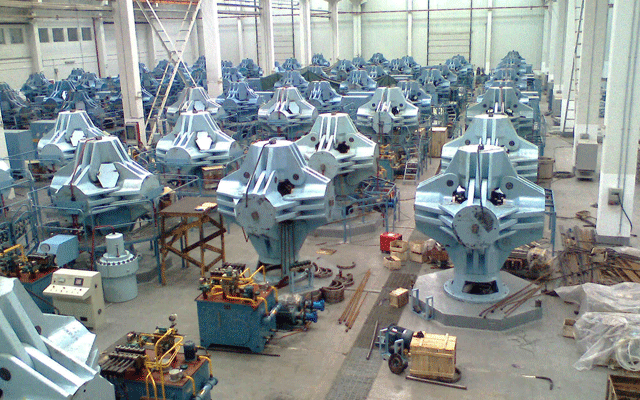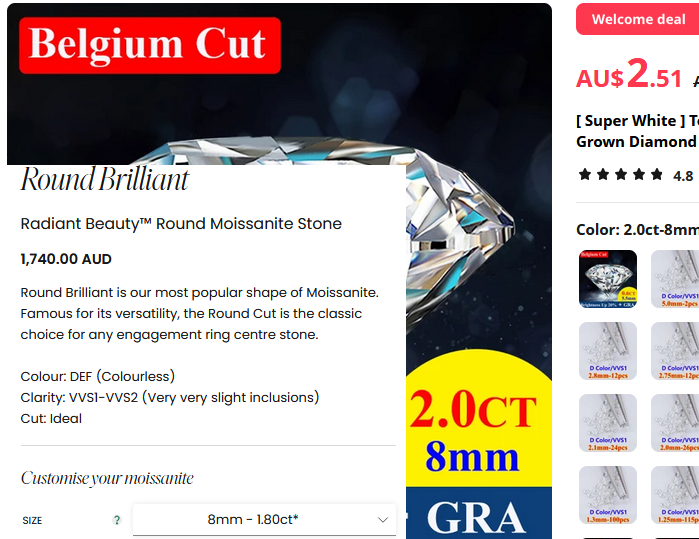As I have written many times before, the price of lab grown diamonds continue their downward trajectory. Being at the end of the first quarter of 2024, now is a good time to reflect on what happened to lab grown prices in the first three months of 2024.
As Predicted – Bigger Stones Way Down, Smaller Stones Not So Much
Last year, I predicted the prices of lab grown diamonds would eventually become linear – that is a two carat will cost double of a one carat, a three carat will be triple the price of a one carat and so on. However, what I didn’t predict was how fast this would happen. As it turns out, this prediction for the most part came true during the past three months. A quick check of our lab grown diamond search reveals the following prices:
- 1ct round brilliant, F/VS1, excellent cut – $530 inc GST.
- 2ct round brilliant, F/VS1, excellent cut – $980 inc GST.
- 3ct round brilliant, F/VS1, excellent cut – $1,416 inc GST.
This pricing reveals that pricing is by no means linear, but in fact, bigger stones are now cheaper per carat than smaller ones. This of course makes sense as bigger stones are easier to grow, take less labour per carat to cut and polish and cost less to certify per carat than smaller stones.
What this also reveals is that bigger stones, say over three carats, lost 30 or more per cent of their value in three months alone, whereas the price drops for smaller stones – one carat and below were a lot more modest. For example, in December 2023, we were selling 3ct round brilliants, F/VS1 quality with an excellent cut for around $2,600 inc GST. Now they are around $1,400 inc GST – a $1,200 drop in three months! However, 1ct diamonds of the same specifications were around $580 inc GST in December 2023, are now $530 inc GST – a modest drop of less than ten per cent.

Above: Lab Grown Prices are Crashing.
How Low Will Lab Grown Prices Go?
Whilst it is difficult to predict what various retailers will do, it is quite easy to predict what will happen to wholesale pricing for lab grown diamonds.
If you look at the cost of raw materials, cutting and polishing and certification, you will see that the cost of the raw materials, that is the rough diamonds, is dropping dramatically. A quick search of Alibaba, reveals mid quality lab grown rough can be purchased for around US$50 per carat. Add around US$30 per carat for cutting and polishing and another $30 per carat for certification, and you will arrive at around US$110 per carat. However, I would imagine that large manufacturers would be able to buy rough for less than what is advertised on Alibaba.
So, let’s assume that it costs US$110 per carat to produce a mid-quality (F-G/VS quality), two or more carat sized lab grown diamond. Add a generous 50% to it and we come to US$165 per carat, which funnily enough is the approximate wholesale price of a 2ct F/VS2 round brilliant at the moment. However, if we were to reduce the cost of the rough to $20 per carat and take away certification all together, this would reduce the cost to US$50 per carat, which may translate to a wholesale cost of just US$75 per carat.
This US$75 per carat figure may seem unbelievable to some, but one only has to look at the prices of small lab grown diamonds (called melee), between 0.005ct and 0.10ct. These currently priced at US$100 or less on the wholesale market, despite there being an apparent shortage of them, according to the commercial director of De Beers’ Lightbox Jewelry.

Above: A Lab Grown Diamond Factory in China Producing a Seemingly Endless Supply.
When Will The Lab Grown Party End?
Whilst lab grown diamonds will continue to grow in popularity, and find new markets with fashion jewellery brands and even new types of jewellery, my opinion is that their popularity for use in engagement rings, barring the low end of the market, will eventually fade away due to their value. As Edahn Golan states in an interview with JCK states:
“What happens when the cost of an engagement ring is under $1,000? People stop buying it. Think about it: Nobody buys a silver ring for their engagement ring. There’s nothing wrong with silver. It’s a sturdy piece of metal, it’s as nice as white gold, but it’s just silver. It costs a tenth less than gold.
At the end of the day, we want to spend a handsome amount of money on an engagement ring. If the conversation today when buying a lab-grown is “My diamond is bigger than yours,” at some point it’s going to be too large, so there won’t be a point in getting a larger diamond. You’re stuck. The conversation will be “What, you don’t want to invest in me? I’m not worth the money?”
I don’t know when it’s going to happen, but I suspect there’s a value, a price below which consumers, especially in the United States, won’t go.”
So whilst a lot of retailers (including Jogia Diamonds) may be enjoying fat margins and profits on lab grown diamonds, unless these retailers are positioned to serve the sub $1500 engagement ring market, or the mainstream fashion jewellery market, they may find themselves in a bit of strife in the not too distant future.

Above: Lab Growns Are Starting to Feel Like a Game of Musical Chairs.
Future Predictions for Lab Grown Diamonds
As alluded to earlier, certification is making up a bigger and bigger part of the cost of a lab grown diamond. However, with the decline in value, certification becomes less and less necessary. However, lab grown diamonds will still need to be graded, and as such, may be graded like pearls. I would suggest a grading system such as this:
- AAA grade: The top – D/IF or D/VVS1
- AA grade: D-F/VVS1-VS1
- A grade: D-H/VS2
- B grade: D-J/SI1-SI2
Whilst some in the industry have suggested automated, or “AI” grading, I think the technology won’t be perfected or become cost effective enough to use on low value lab grown diamonds in the near future. However, as the technology improves, automated grading, and even automated polishing may become a reality for lab grown diamonds.
Secondly, I think retailers will have to re-think their lab grown strategy. Those retailers whose marketing strategy includes being critical of natural diamonds may all of a sudden need to pivot toward “eco-friendly” natural diamonds (with or without the use of some other buzzword) in order to keep customers in the fine jewellery market.
Similarly, we are very close to the point whereby a lot of retailers will have to set a price floor for lab grown diamonds. This may be $500 per carat or $1,000 per carat – whatever it takes for the retailer to make a profit – despite them being worth a fraction of that amount. Some retailers may even give them away for free if you buy a natural diamond or spend over a certain amount.

Above: An Australian Jeweller’s Moissanite Pricing vs What Moissanite is Really Worth. Could This Happen to Lab Grown Diamonds?
Over the past decade, the lab grown diamond industry has dealt with declining prices. However, these past three years, and especially this past quarter has seen an absolute bloodbath for lab grown diamond prices. Much of the controversy surrounding lab grown diamonds has been their use in fine jewellery, with a majority of jewellers now selling lab grown diamonds. However, as prices, at least on the wholesale level, decline to the point to where they are virtually worthless, it will remain to be seen if lab grown diamonds will continue to used for fine jewellery, especially engagement rings, or be consigned to the fashion and low end jewellery market.
July 12th, 2024 at 3:30 am
This is an angry biased obvious bought and paid for article by an anti lab grown alt universe party like many of the ONLY NATURAL DIAMOND retail Jewelers that are losing EVERY DAY…Lab grown gemstones are only $ increasing at Retail as adoption and market share continues to skyrocket at RETAIL( 35% in 2nd half 2023 to 1st half 2024 !).Profitability has been a saving grace for retail jewelers smart enough to ” join ’em” vs berate & BEAT THEM…as Nat Diamonds have priced themselves out of viability for the avg. buyer…The Best of the Best ( white colorless , not yellowed or grey) are only coming out of India & now USA as cap investment has been made in expensive high quality BEST CVD & HPHT machinery, unlike cheap fast grow China product ( Note/ Qualifier : Some product from China is exceptional but you MUST know who to buy from )..What will happen is the OPPOSITE of what THIS writer thinks…a hard cap on production & export/import will stabilize the value of lab growns AND create a 2ndary mkt for them at Value…Supply & Demand still rules and Lab grown 8ndustry while 70yrs old is actualy an infant in adoption and maturity as an industry FORCE …Here to STAY..Take the Stick out your Butt and join the REVOLUTION BUDDY..SRK 💎💍💎
July 12th, 2024 at 1:43 pm
Hi Saul…many thanks for your comments. I don’t think it is angry at all, and certainly not bought or paid for by an anti lab grown party. However, I do find it funny that certain lab grown sellers (like you I guess) get very upset at the mere mention of what is happening with the lab grown market.